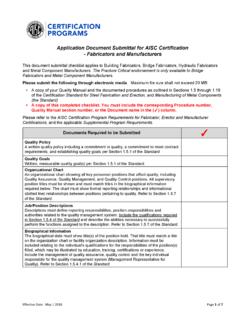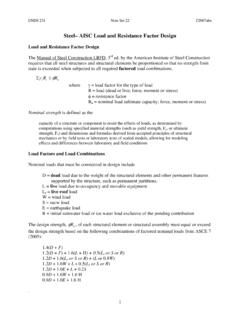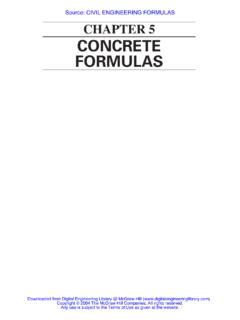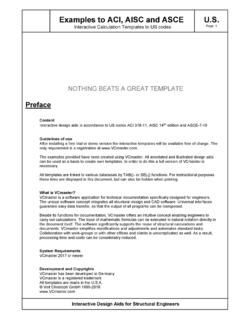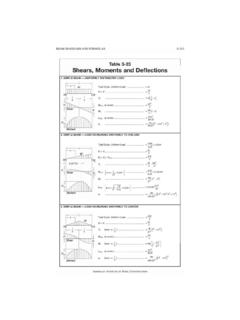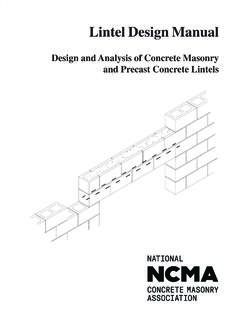Transcription of Design of Skewed Connections - AISC
1 140 / ENGINEERING JOURNAL / THIRD QUARTER / 2001 ABSTRACTS kewed Connections result when members frame to eachother at an angle other than 90 . This paper providessome guidance in the choice of connection, based on safetyand economy, and discusses some of the Design considera-tions required for these standard connection details assume that the membersbeing connected frame at right angles to each other. In moststructures there will be some members, which do not meetat right angles. These are referred to as Skewed require special Design considerations to provide forsafety while providing an economic FOR Skewed Connections TO BEAMSThe preferred Skewed Connections for economy and safetyare single plates (Figure 1) and end plates (Figure 2).
2 Sin-gle bent plates (Figure 3) and eccentric end plates also workwell at very acute angles. The old traditional double bentplate Connections are difficult to accurately fit and areexpensive to fabricate. There are also quality (safety) prob-lems with plate cracking at the bend line as the anglebecomes more plates (Figure 1) are the most versatile and eco-nomical Skewed connection with excellent dimensionalcontrol when using short-slotted holes. While capacity islimited, this is usually not a problem because Skewed mem-bers generally carry less tributary area.
3 Using the standard3-in. hole gauge from the AISC LRFD Manual of SteelConstruction Connection Tables (AISC, 1994), singleplates can be utilized for intersection angles of 90 to 30 .Snug-tight bolts are preferred because they are more eco-nomical and greatly simplify installation when there areadjacent beams. They also eliminate the banging bolt problem, which occurs in single plate Connections whenpretensioned bolts slip into bearing. The AISC tables can beused to select the required plate size and bolts along withthe weld capacity for the required load.
4 This connection hasan eccentricity related to physical distance a between thebolts and the weld as shown in Figure 1. The actual eccen-tricity depends on support rigidity, hole type, and boltinstallation. For a flexible support and standard holes, the eccentricityfor the bolts iswhere nis the number of a flexible support with short-slotted holes, Design of Skewed ConnectionsLARRY KLOIBER and WILLIAM THORNTONL arry Kloiber is vice-president, LeJeune Steel Co., Min-neapolis, Thornton is president, Cives Engineering Corpora-tion, Roswell, 1.
5 Shear tab (single plate).Fig. 2. Shear end a rigid support and standard holes,For a rigid support and short slotted holes,When it cannot be determined whether the support isrigid or flexible, the larger value of ebfrom the above equa-tions can be eccentricity for the bolts, eb, is measured from theface of the support. Therefore, the eccentricity for the weld,ew, is ew= eb+ a. However, rather than using this value,AISC recommends that the weld size be such that the plateyields before the welds yield. For A36 plate and E70 elec-trodes, this requires that the fillet weld size is a minimum of3/4of the plate actual weld detail does, however, have to be devel-oped for the Skewed joint geometry, as will be shown plates (Figure 2) designed for shear only are able toprovide more capacity than single plates and if horizontalslots are utilized with snug-tight bolts in bearing, somedimensional adjustment is possible.
6 Hole gages can beadjusted to provide bolt access for more acute skews. Theonly real constructability problem arises when there areopposing beams that limit access to the back side of theconnection. These end plate Connections can be sized usingthe AISC tables to select plate size, bolts, and weld capac-ity. Note that there is no eccentricity with this joint. Theweld detail, however, has to be adjusted for the actualgeometry of the joint in a manner similar to the shear bent plates (Figure 3A) can be sized for eitherbolted or welded Connections using procedures similar tothose in the AISC Manual(AISC, 1994) for single angleconnections.
7 These involve two eccentricities, e1, and e2from the bend eccentricities are measured from the bend linebecause the plate has effectively zero bending strength outof variation on the single bent plate of Figure 3A is shownin Figure 3B, where an angle is used providing a 90 eccentricities e1and e2are again measured from the bend line, which is at the intersection of the two legs ofthe angle. Note that this connection places an eccentric loadon the carrying beam , which may need to be considered inthe Design of this beam and its end plates (Figure 4) can be easily designed forthe eccentricity eusing the tables in the AISC Manualforeccentrically loaded bolt FOR Skewed Connections TO COLUMNSS kewed Connections to wide flange columns present specialproblems.
8 Connections to webs have very limited accessand except for columns where the flange width is less thanthe depth, or for skews less than 30 , Connections to flangesare JOURNAL / THIRD QUARTER / 2001 / 141 Fig. 3A. Bent 3B. Use of angle in place of single bent 4. Eccentric end / ENGINEERING JOURNAL / THIRD QUARTER / 2001 When connecting to column webs, it may be possible touse either a standard end plate or eccentric end plate asshown in Figures 5 and 6. Single plate Connections shouldnot be used unless the bolts are positioned outside the col-umn flanges.
9 This will make the connection so eccentricthat top and bottom plates, as shown in Figure 7, may beneeded. Extending the single plate increases the connectioncost and, unless the connection is designed for the increasedeccentricity (eof Figure 7), the column must be designedfor it. Except for Figure 7, the eccentricities for these con-nections are the same as similar Connections to beam Connections to the column flange will also beeccentric when the beam is aligned to the column center-line. However, if the beam alignment is centered on theflange, as shown in Figure 8, the minor axis eccentricity iseliminated and the major axis eccentricity will not generallygovern the column Design .
10 The connection eccentricity isrelated to the parameter ahere in the same way as was dis-cussed for Figure 1. It is reasonable to assume that the col-umn provides a rigid support in Figure the beam is aligned to the column centroid eithersingle plates (Figure 9), eccentric end plates (Figures 10and 11), or single bent plates (Figure 12) can be used. Theeccentricity for each of these Connections is again similar tothat for the same connection to a beam web. An additionaleccentricity ey, which causes a moment about the columnweak axis, is present in these Connections as shown in Fig-ures 9 through 12.






